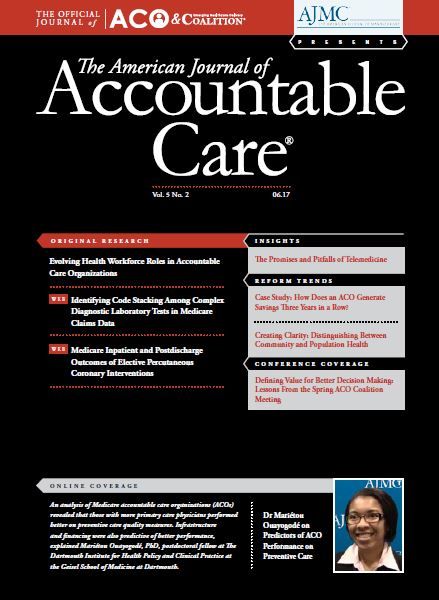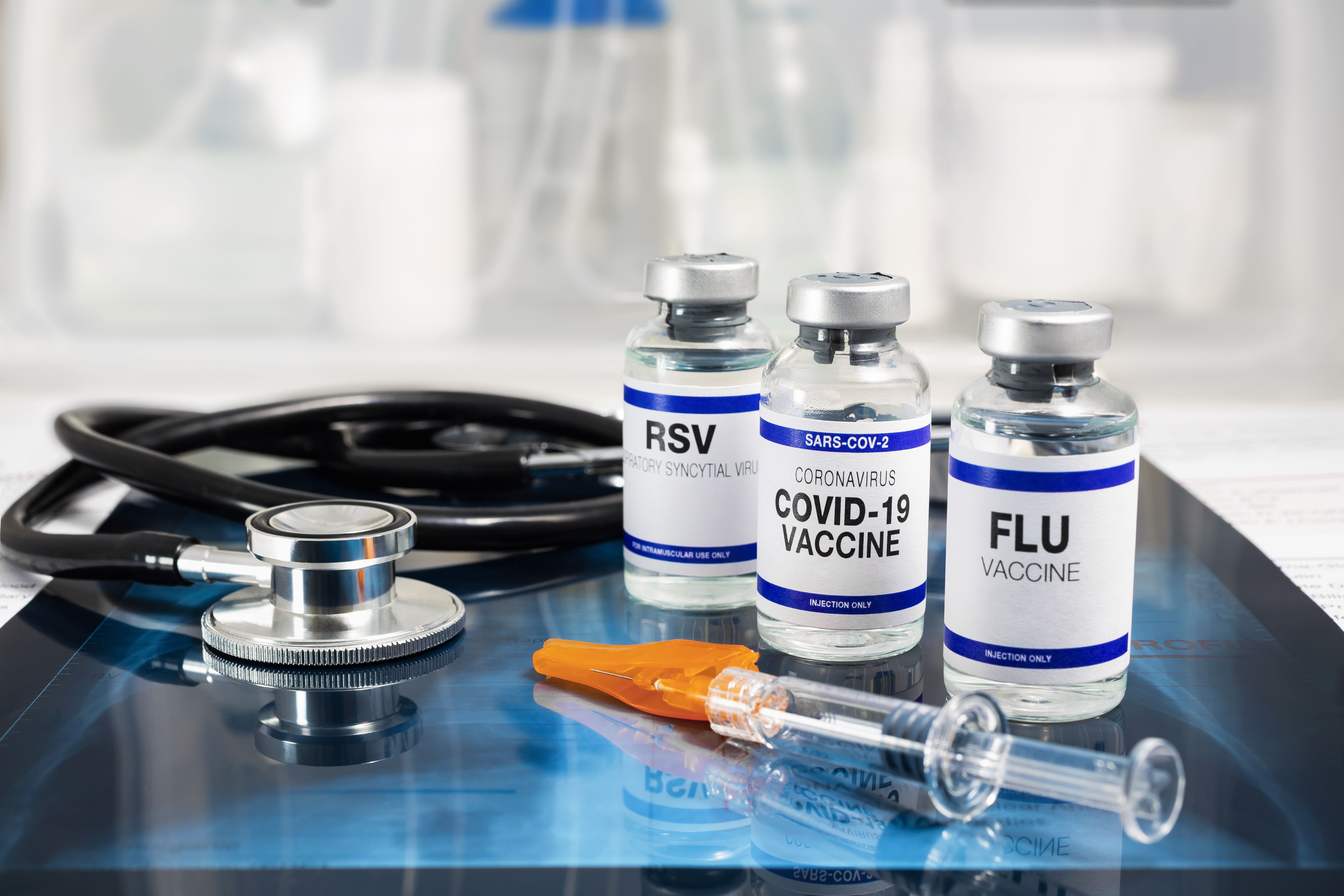Publication
Article
Population Health, Equity & Outcomes
Case Study: How Does an ACO Generate Savings Three Years in a Row?
Author(s):
Increasing accountable care organization savings is dependent on maximizing quality scores and increasing the number of beneficiaries while maintaining a low per-capita spend through efficiencies of care.
ABSTRACT
Our accountable care organization quality scores improved and savings were achieved 3 years in a row, with $33 million realized in 2015. How did this happen? Our initial steps were to select physicians whose practices were certified as patient-centered medical homes and to provide them with nurse care coordinators to help manage high-risk, high-cost patients and to assist with quality measure compliance. We continued to add hospitals and providers, which significantly increased the number of patients, which in turn provided a multiplier effect for savings. From the beginning in 2012, the number of inpatient admissions, readmissions, emergency department visits, and ambulatory care—sensitive conditions were reduced, and this trend continued each year. Critical to these trends was the close and frequent physician office follow-up visits. Excessively expensive areas were addressed, such as overuse of skilled nursing facilities and ambulance use for patients undergoing dialysis.
The American Journal of Accountable Care. 2017;5(2):27-31
In 2015, our accountable care organization (ACO) saved approximately $33 million. How did that happen when we saved approximately $10 million from 2012 to 2013 and $6 million in 2014? Why did the savings go up so dramatically when we thought that they would actually go down? Are there some lessons to be learned from this result?
As part of the background for this case study, the Hackensack Physician—Hospital Alliance ACO, LLC (dba Hackensack Alliance ACO), located in New Jersey, became part of the Medicare Shared Savings Program (MSSP) in April 2012. The hospitals participating in our MSSP are Hackensack University Medical Center, Hackensack UMC–Pascack Valley Hospital, Hackensack UMC–Mountainside Hospital, Hackensack UMC–Palisades, and Englewood Hospital. There are 329 practitioners who care for 23,156 assigned beneficiaries. An electronic health record (EHR) is used by over 90% of practitioners, but with more than 5 different EHR platforms. Methods for calculating shared savings and assessing the quality performance of an ACO have been previously reported.1
Initial Personnel Selection Criteria
Before presenting our financial results, we should point out that the physicians selected to participate in our ACO are required to be certified as a patient-centered medical home (PCMH) by the National Committee for Quality Assurance (NCQA). Alternatively, they can still join our ACO if they agree to be certified by NCQA as a PCMH within the year; we would then pay for a trainer to have them certified. We have this requirement because PCMH-certified physicians understand the future of healthcare and are willing to cooperate with the changes taking place.1
The other major personnel factor is that we hire nurse-level care coordinators and place them into the practices to help with high-risk patients and to aid in ensuring compliance with the 33 quality measures. The care coordinators purposely are not located in a central office because that would remove them from the “action.” We strategically recruit nurses with excellent “people skills” and work ethic who are clinical experts in the specialties pertinent to the MSSP population (ie, diabetes, cardiac, renal, and geriatric/homecare).
Total Savings
Now let us compare our financial results. The total savings in 2015 was $33,353,310 (sourced via confidential data from the A1006 Hackensack Physician-Hospital Alliance ACO, LLC, Financial Reconciliation Report, Performance Year 2015, of the Medicare Shared Savings Program [April 1, 2012, agreement start date]). When our ACO’s quality score and sequestration adjustment were factored in, our 50% came to $15,640,878. Medicare keeps the remaining amount. In prior years, the total savings realized were $10,747,669 for 2012 to 2013 and $6,464,895 for 2014 (sourced via confidential data from the A1006 Hackensack Physician-Hospital Alliance ACO, LLC, Financial Reconciliation Report, Performance Year 2 [2014], of the Medicare Shared Savings Program [April 1, 2012, agreement start date]). Consequently, the dramatic increase in 2015 was a surprise. What accounted for this increase?
Increasing Assigned Beneficiaries
One key factor is the significant increase in the number of assigned beneficiaries. The actual number of beneficiaries in 2014 was 15,603 (or 15,158 person-years), and in 2015, was 23,156 (or 22,522 person-years). The difference is a 48.4% increase in 1 year (Figure 1), which allowed a multiplier effect. Compared with 2014, we were able to multiply the per-beneficiary cost savings by a much larger number of beneficiaries (or person-years) in 2015. Person-years are shown because they more accurately reflect how long each person or beneficiary is part of the ACO in the performance year.
Increasing Providers
What led to the assigned beneficiary increase was a significant increase in the number of providers. That number rose from 234 in 2014 to 329 in 2015, representing a 40.6% increase in providers. The increase occurred because the number of hospital sites participating in our ACO rose; in particular, there was the addition of Palisades General Hospital physicians, as well as internal growth of the number of physicians in existing practices.
Quality Scores
Because half of the total savings is multiplied by the ACO’s quality score, the higher the quality score, the closer the ACO is to getting all of the 50% of the total savings. In our ACO, compliance with the 33 quality measures improved from 2014 to 2015. The score in 2014 was 89.43%, whereas the score in 2015 rose to 95.70%. The improvement is due, in part, to the feedback each Tax Identification Number group receives on past quality measure performance compared with our whole ACO as a unit. In addition, we place an emphasis on reporting to the whole ACO the measures where compliance is low.
We also tracked our quality performance by monitoring a Care Gap Index (CGI), using the Verscend Technologies, Inc, (formerly known as Verisk Health) Provider Intelligence application (Verscend Technologies, Inc, Waltham, Massachusetts). The CGI is a care compliance measure that is a weighted calculation of an individual’s compliance with the quality measures. The measures are weighted based on clinical importance, and the CGI score represents the degree to which the individual has missed recommended care guidelines. The group score is an average of all individuals in the group. Higher CGI scores correspond to a greater number of deviations from evidence-based care within a population. Therefore, in this index, a lower score is better. During the most recent analysis period, our patient population CGI group score was 1.72, substantially lower than the ACO mean group CGI score of 4.98.
Risk Score
It should be pointed out that our patient population is high risk, which contributes to our high benchmark expenditures. Our patient population’s disease burden, calculated using analytics via the
Provider Intelligence application from Verscend and Premier, is higher than that of the average ACO. Consequently, our beneficiaries tend to be sicker and have more complex care needs than those of the average ACO, and are therefore costlier. The actual numbers tell a better story. In 2014, our population risk index was 24.34 versus an ACO mean norm of 17.17, and in 2015, our risk index was 21.65 versus an ACO mean norm of 16.76.
Total Expenditures
The total expenditures in 2014 dropped by 3.26% over the course of the year (ie, $198,546,103 — $192,081,207 = $6,464,896). In 2015, the annual drop was significantly higher at 10.96% ($304,196,419 – $270,843,109 = $33,353,310) (Figure 2). The per-capita benchmark expenditures for 2014 were $13,099, as calculated by dividing the $198,546,103 in expenditures by the 15,158 person-years. It is of note that our per-capita expenditures benchmark actually went up in 2015, which is contrary to the common perception that benchmarks will go down over time. In the first 2 years of the MSSP program, the benchmarks in each year were neutral to decreasing, whereas in the third year of 2015, the national benchmark rose a few percentage points. The actual per-capita benchmark for 2014 was $13,099, whereas in 2015, the per-capita benchmark rose to $13,507. Contributory to this paradoxical phenomenon is that historical benchmarks are adjusted up by CMS when the ACO has had savings in the past.
Sequestration Adjustment
Before we identify a figure for total savings, we must take out the sequestration adjustment, which is the mandatory reduction in federal budgetary resources required by the Budget Control Act of 2013 after the federal government was temporarily shut down. For our ACO, this tax rose from $57,816 in 2014 to $319,202 in 2015. The number is 452.10% higher because the tax is 2% of the total savings, which had increased significantly in 2015.
Effect of Quality Performance
×
×
To get to our final shared savings amount, we have to account for our quality performance. In 2014, our quality score was 89.43%, so we were only able to qualify for 44.72% of our savings (50% 89.43%). In 2015, that percentage rose because our quality score rose to 95.70%. Consequently, we were able to qualify for 47.9% of the savings (50% 95.70%). This is what CMS intended: the higher your quality score, the closer you get to keeping 50% of the total savings. At this point, we need to subtract the sequestration adjustment to determine the actual amount of our shared savings that CMS funds to the ACO.
Final Sharing Amount
Our final sharing amount less sequestration was $15,640,878 (ie, $15,960,080 — $319,202).
Skilled Nursing Facilities
Those are the overall numbers for our ACO shared savings. Now let’s look at the specific areas of potential savings that we addressed this past year. In 2015, the newest area addressed was the skilled nursing facility (SNF). From comparative data in a Premier Inc collaborative, we realized that our SNF spend, days, and discharge rates were much higher than those of our peers in the collaborative. We identified the SNFs that we used most often and spoke with their managers. We essentially mandated that patients be discharged at the time they were identified as potential discharges rather than waiting for the maximum number of days that Medicare will cover. We also put our nurse care coordinators and
physician SNFs in the nursing homes to attend daily rounds where decisions on discharges are made. In addition, we convinced the nursing facilities to accept the physical therapy days recommended by the hospital when the patient was transferred to the SNF rather than reassessing the patient on arrival in the nursing facility and making a recommendation for a longer duration of days than the hospital recommended.
We are aware that there are important differences in incentives between the hospital and the SNF. In the hospital, payment is made based on diagnosis (ie, Diagnosis Related Group) whereas payment is per diem in the SNF. The SNFs cooperated with our approach, and implementation of this plan resulted in a quarterly decline in the number of days spent in the SNF: from 3067 days in the first quarter of 2015 to 2484 days by the fourth quarter—a 19.0% drop in days.
Other New Initiatives
Other new initiatives occurred in end-stage renal disease (ESRD). Although this was a tiny part of our overall expenses, the cost was very high on a per-beneficiary basis. We looked into it and realized that almost half of the expense was related to the widespread use of ambulances to transport the patients to and from the dialysis facility. We approached the issue initially, but then Medicare dealt with it on a national basis because ambulances are not supposed to be used indiscriminately. Ambulance use per assigned beneficiary dropped from 203 in the first quarter of 2015 to 97 in the fourth quarter, a decline of 54.68%. In addition, per-capita expenditures for ESRD dropped from $136,774 to $103,686, a decrease of 24.19%, over 2015.
Follow-up on Old Initiatives That Affect Utilization
We continued to pursue the utilization areas that we focused on from the start in 2012, as follows: a) short-term inpatient admissions per 1000 person-years decreased by 14.29% (322 — 276 = 46), and b) emergency department (ED) visits per 1000 person-years decreased by 9.15% (612 – 556 = 56).
We also continued to work on the transition of care utilization as follows: 30-day all-cause readmissions per 1000 discharges reduced by 17.33% (202 — 167 = 35). Additional efforts dealt with ambulatory care–sensitive conditions (ACSCs) discharge rates per 1000 beneficiaries. ACSCs are medical conditions that are potentially preventable as an admission. The top 3 were: 1) exacerbations of chronic obstructive pulmonary disease (COPD) or asthma decreased by 14.12% (10.27 – 8.83 = 1.45), 2) exacerbations of congestive heart failure decreased by 27.27% (13.68 – 9.95 = 3.73), and 3) bacterial pneumonia decreased by 18.81% (8.40 – 6.82 = 1.58). There was 1 important factor that did not decrease: 30-day postdischarge provider visits per 1000 actually increased (821 – 831 = +10. This increase indicates that providers continued to follow their patients closely in the office rather than having them admitted to the ED or as an inpatient to the hospital.
Review of Lessons Learned
Let us review what we have learned about increasing the level of savings. First, it is important to set the stage right in the beginning. To do this, we pick physicians who accept the future of healthcare as indicated by their getting certified as a PCMH by NCQA. Then we provided them with a nurse coordinator in their office to help them care for their high-risk patients and aid them in complying with the 33 quality measures. Next, we continue to add providers, which in turn increases the number of beneficiaries. In doing so, the eventual per-capita savings will be multiplied by a higher number of beneficiaries (or higher number of person-years). A focus on compliance with the quality measures means that when the quality score is multiplied by the 50% sharing allowed by CMS, the ACO will receive a percentage as close to 50% as possible after the sequestration adjustment is deducted. We also continue to work on reducing the “low-hanging fruit,” such as lowering inpatient admissions, readmissions, and ED visits. At the same time, there is also a focus on minimizing ACSC admissions, such as heart failure, pneumonia, and COPD.
Finally, we turn our focus to new areas, such as reducing length of stay in SNFs. Alternatively, in the future, we can consider other opportunities in postdischarge care, such as home care, hospice care, and hospital outpatient services; examine the use of suppliers and durable medical equipment. We can also consider condition-specific categories like oncology, ESRD, and behavioral health. Finally, we can review patient experiences and their use of telemedicine. In general, we tend to focus on areas where our expenses appear excessive or the quality of care appears to need improvement.
Conclusions
This approach should help an ACO increase the quality of care while reducing expenses at the same time. Once an ACO is on this path, it is likely that savings will continue to accumulate over time.2 As the savings occur over time, bonuses are paid out and aggregate spending is reduced. Medicare itself has achieved a net savings.3
Author Affiliations: Hackensack Meridian Health (PAG, MM, ME, EG, LN, DP, MS), Hackensack, NJ; Verscend Technologies (JAC, JH), Waltham, MA.
Source of Funding: Funding supported by Hackensack University Medical Center.
Author Disclosures: Dr Colbert and Ms Hart are employed by Verscend Technologies, Inc. The remaining authors report no relationship or financial interest with any entity that would pose a conflict of interest with the subject matter of this article.
Authorship Information: Concept and design (PAG, MM, EG, LN, DP); acquisition of data (PAG, MM, ME, EG, JH); analysis and interpretation of data (PAG, MM, ME, EG, LN, JAC); drafting of the manuscript (PAG, LN); critical revision of the manuscript for important intellectual content (PAG, MM, JAC, JH, DP); statistical analysis (PAG, ME); provision of study materials or patients (ME, EG); obtaining funding (PAG, MS); administrative, technical, or logistic support (PAG, MM, EG, JAC, DP, MS); and supervision (PAG, MM, EG, LN, JAC, DP, MS).
Send Correspondence to: Peter A. Gross, MD, Hackensack Meridian Health, 30 Prospect Ave, Hackensack, NJ 07601. E-mail: Peter.Gross@hackensackmeridian.org.
REFERENCES
1. Gross PA, Easton M, Przezdecki E, et al. The ingredients of success in a Medicare accountable care organization. Am J Account Care. 2016;4(2):42-50.
2. A look at MSSP ACO performance years 1-3. NAACOS website. https://naacos.memberclicks.net/assets/docs/news/naacosreport-acoperformanceyears1-3.pdf. Published September 2016. Accessed December 3, 2016.
3. McWilliams JM. Changes in Medicare Shared Savings Program savings from 2013 to 2014. JAMA. 2016;316(16):1711-1713. doi: 10.1001/jama.2016.12049.

Newsletter
Stay ahead of policy, cost, and value—subscribe to AJMC for expert insights at the intersection of clinical care and health economics.





